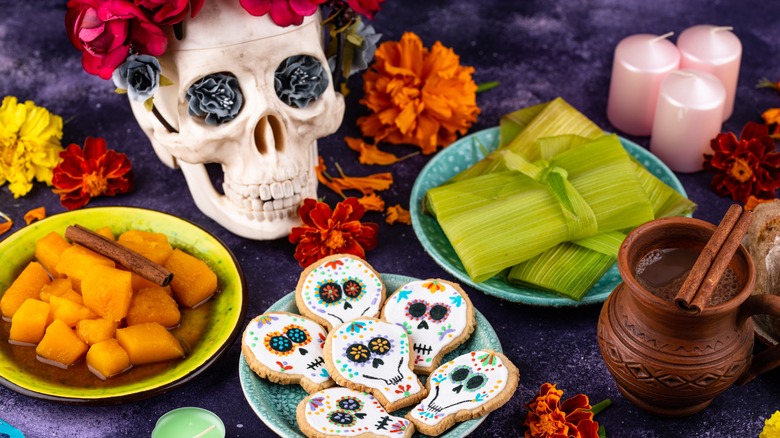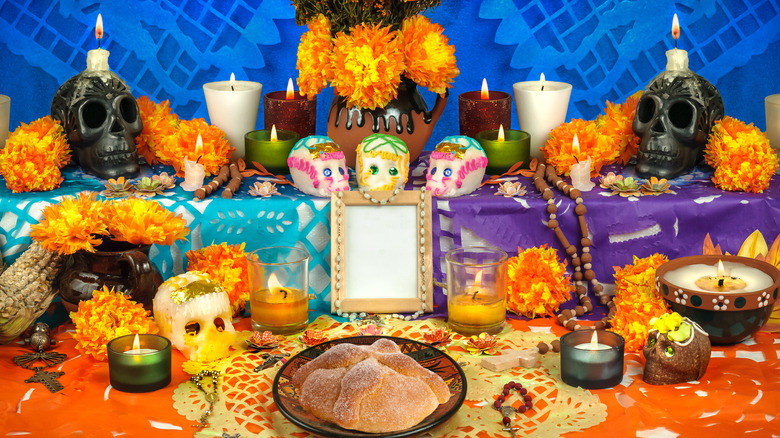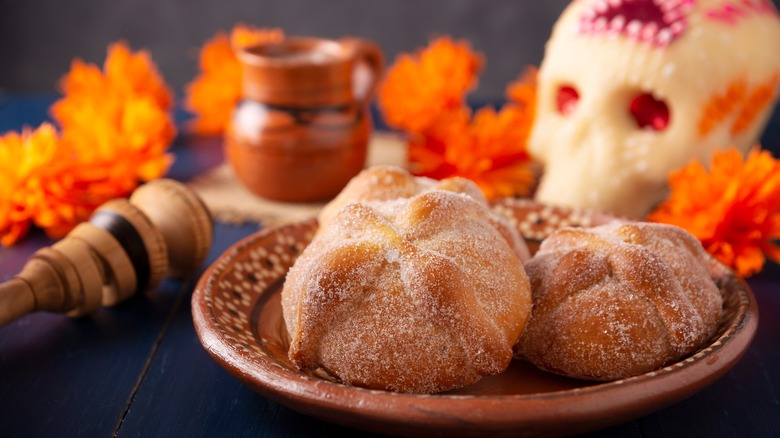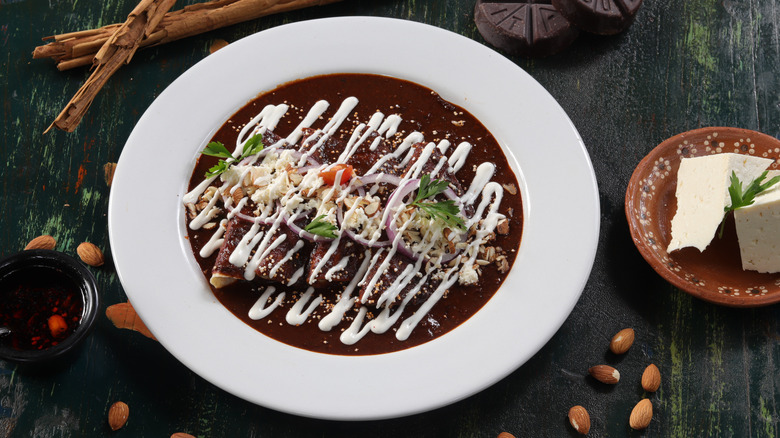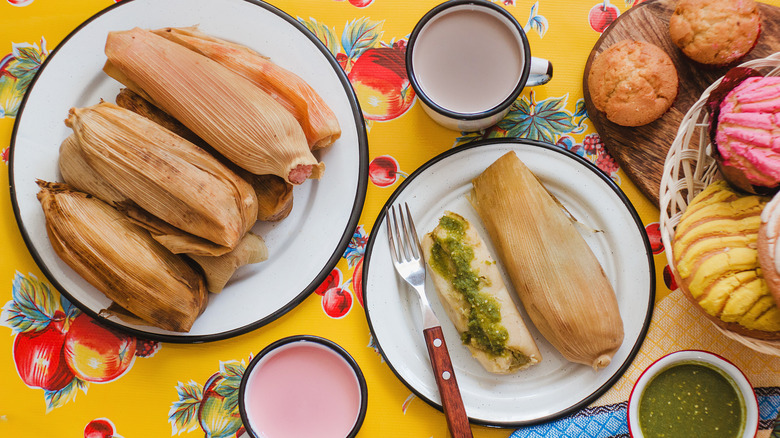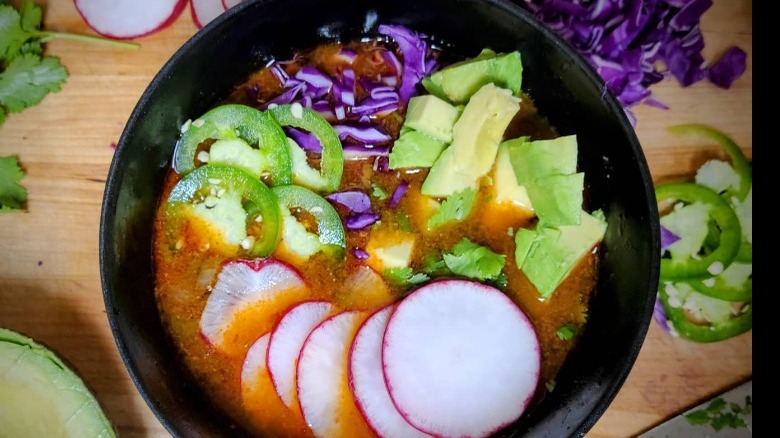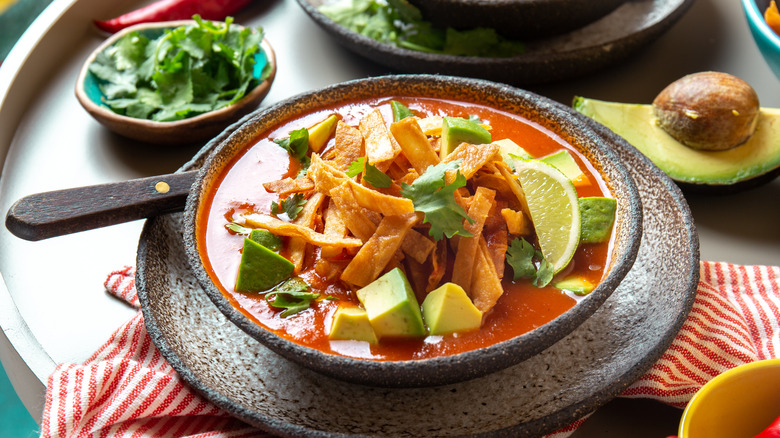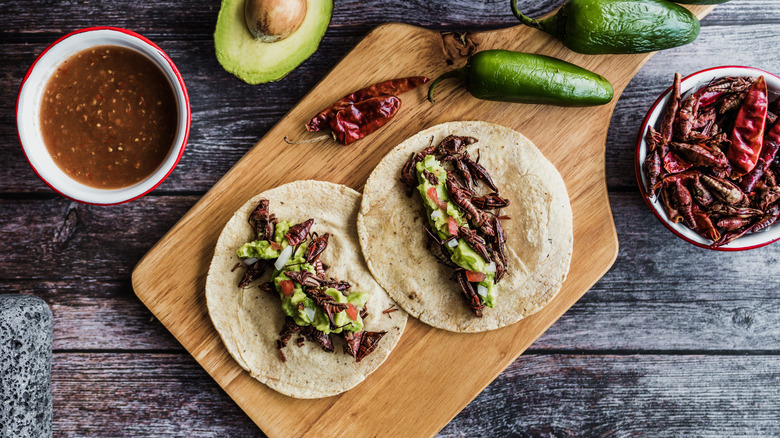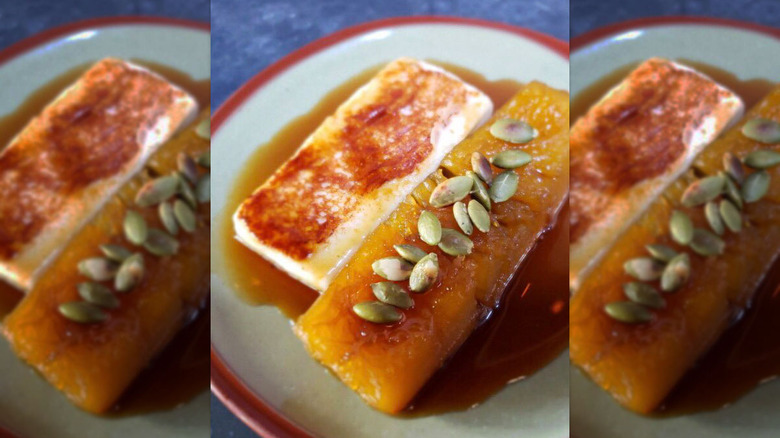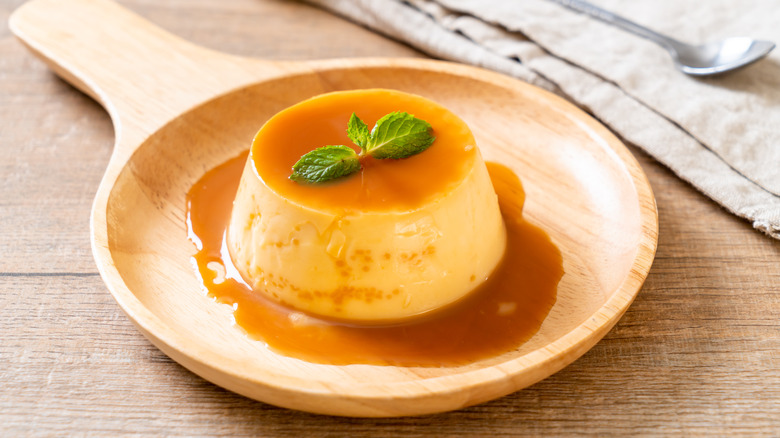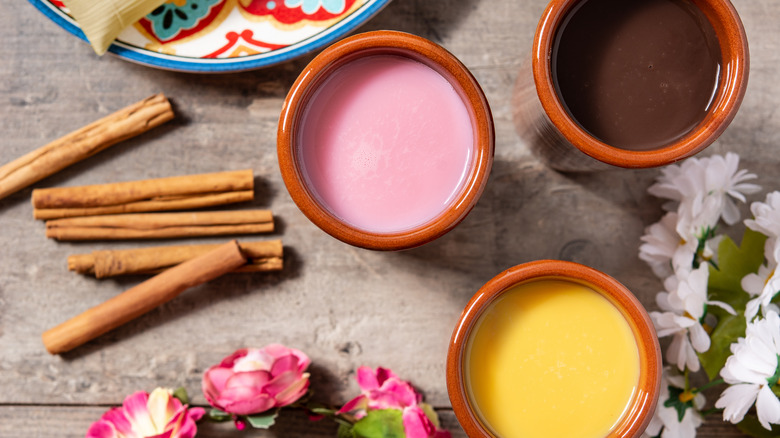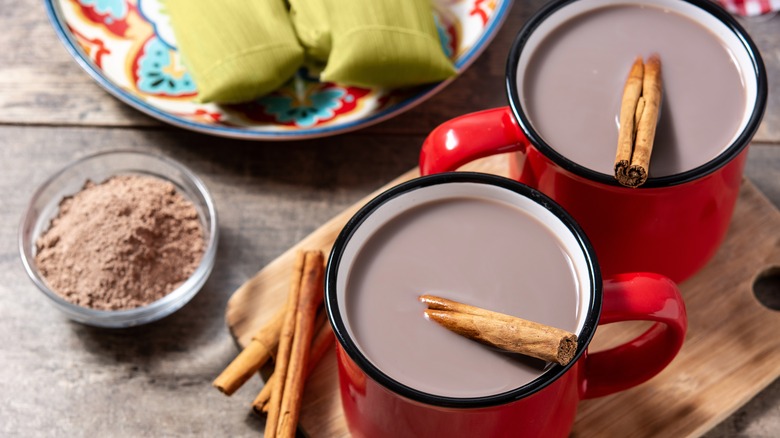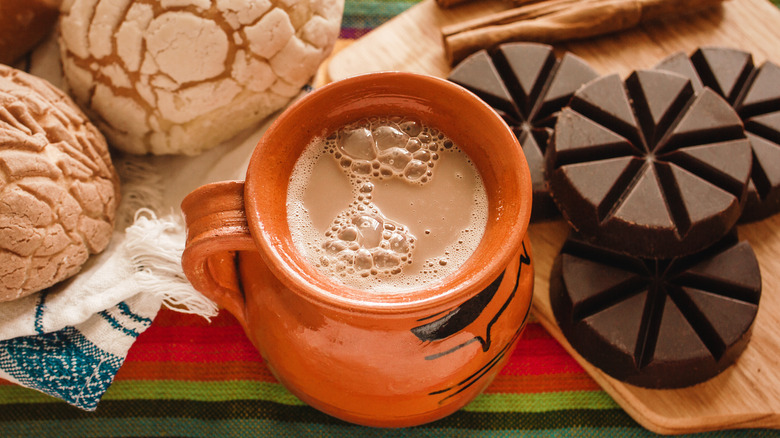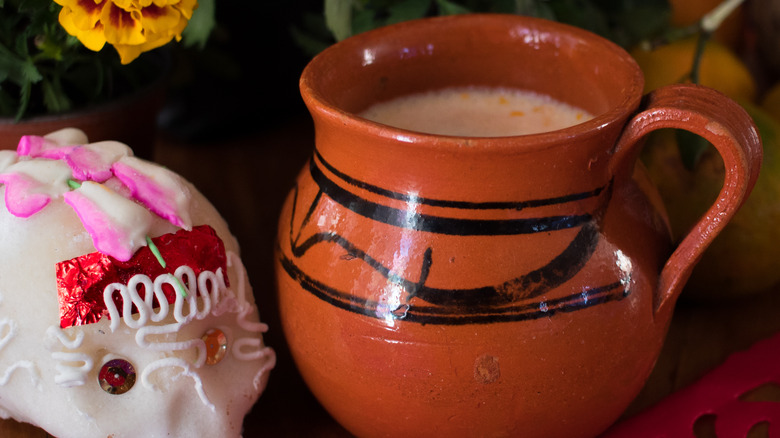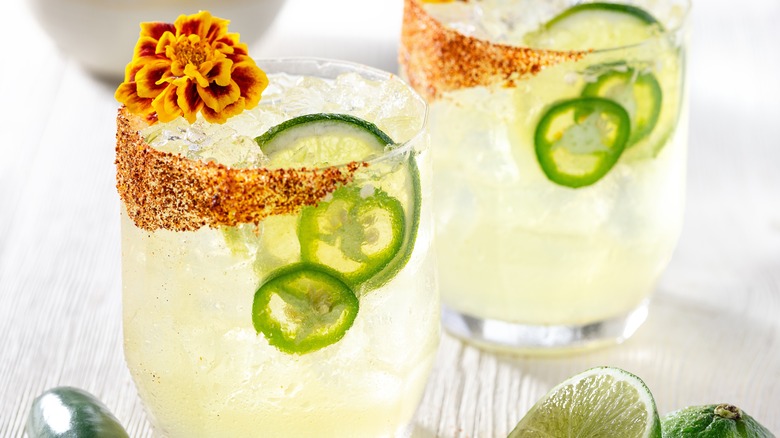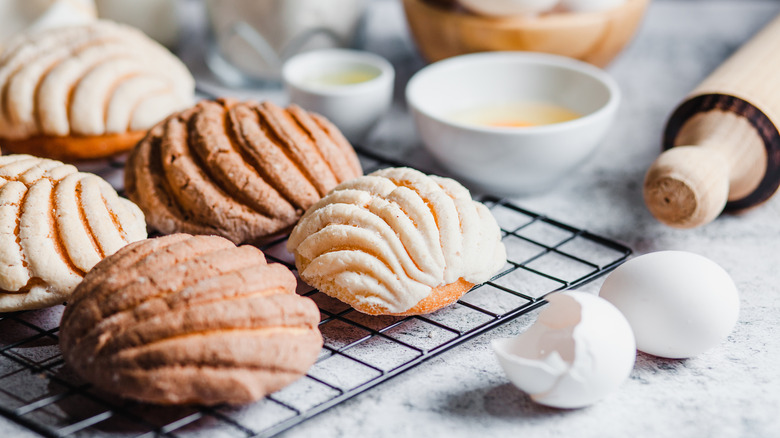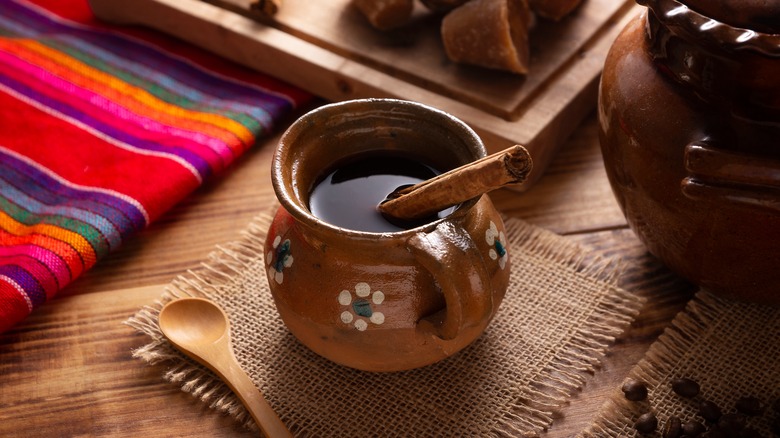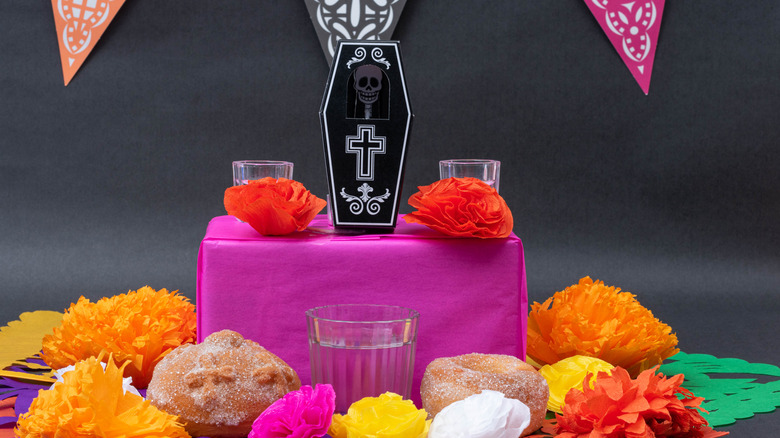17 Traditional Foods To Try For Day Of The Dead
Traditional Mexican foods and drinks are at the heart of the Day of the Dead. Between November 1st and 2nd of every year, Mexican families visit the graves of those who have passed or make ofrendas (offerings) to the dead on special altars (via Britannica). Largely, these ofrendas are foods and drinks their loved ones enjoyed while they were living. For example, you might offer conchas because they were your grandma's favorite pastry and champurrado since you have fond memories of drinking it with your grandpa. However, the food and drinks on the Day of the Dead are not only for the dead; families feast together.
The Day of the Dead (Día de los Muertos) originated with the indigenous people of Mexico. Scholars think it was connected with the changing seasons or asking the dead and nature to help bring a good corn harvest. Then, when the Spaniards converted the natives to Catholicism, they wrapped up the Day of the Dead traditions with All Saint's Day and All Soul's Day (via The New York Times). Over time, it's grown to be a colorful day of remembrance full of sugar skulls, tasty foods like tamales and red pozole, and drinks like atole and pulque. If you're lucky, you may find some of these tasty foods and drinks at a Mexican restaurant near you on el Día de los Muertos.
Sugar skulls (calavaras)
One of the most iconic parts of the Day of the Dead is sugar skulls. In Mexico, they're used as offerings to place on Day of the Dead altars. The idea behind the offerings and skulls is to convince dead loved ones to visit. NPR also says that friends exchange colorfully designed sugar skulls meant to reflect the energy of life. So, they're a gift you give loved ones in both life and death.
Mexicans make sugar skulls now in the same way they did in the 17th century. The creation of traditional sugar skulls involves pouring boiled sugar into a clay mold that you can break away once it's dry. According to Mexican Sugar Skull, Sugar skull makers hide the source of their molds and often travel out of state to make sure they're getting unique ones that truly reflect the soul of the deceased family member.
Recipes for sugar skulls contain edible ingredients like powdered sugar and meringue powder. However, most sugar skulls you buy will also include inedible decorations like foil, glitter, and beads, which means they're not meant to be eaten. However, it's not uncommon to celebrate the Day of the Dead with edible sugar skulls. One edible version of sugar skulls is sugar skull cookies, which you may be able to find at your local bakery (via Instagram). If you're lucky, you may even run across individual sugar skull cakes (via Instagram).
Pan de muertos
Another food you'll see at every Day of the Dead celebration is pan de muertos (bread of the dead). Elizabeth Hernandez of La Patrona Bakery told The New York Times that pan de muertos is "a symbol of their death, but at the same time, life." Pan de muertos has a texture similar to challah or brioche and often contains a dusting of sugar on top. Often, bakers add shapes on top that look like skulls and crossbones, but recipes vary regionally. Some contain sesame seeds while others may have anise seeds or orange blossom flavoring. Some bakers even add pre-made, painted caritas (little faces) to the top of the bread. You can even find some with a cream or chocolate filling (via Bloomberg).
Families usually make multiple loaves of pan de muertos or pick up multiple loaves from the bakery –- some for the family to eat and some to use as an ofrenda for dead loved ones (via Big 7 Travel). If you can find pan de muertos at your local Mexican bakery or restaurant, don't forget to pick up some Mexican hot chocolate to go with it.
Mole negro
Mole negro is a rich black sauce that originated in Oaxaca in central Mexico. This flavorful sauce is enjoyed during Día de los Muertos and contains over 30 ingredients. Some of the aromatic ingredients include Mexican chocolate, allspice, peppercorns, and cloves. Making mole negro takes all day to prepare because of the process of grinding, roasting, and blackening the ingredients by hand. This process gives the sauce its signature smoky flavor (via Big 7 Travel). Making mole negro is a labor of love, and it often brings various generations of the family together for the process (via Global Eats NYC).
Since making homemade mole is such an involved process, you're not cheating too much if you decide to buy mole negro sauce instead of spending a whole day making it. It gets its bulk from ingredients like chiles, plantains, sesame seeds, raisins, nuts, garlic, and onions. It's also full of spices like thyme, cloves, cinnamon, cumin, pepper, and oregano. While it contains sugar, it does not contain any Mexican chocolate, so you'll have to add it yourself. However, be sure to buy it early because it sometimes sells out before the Day of the Dead.
Tamales
Another Day of the Dead food tradition that takes a lot of effort to make and often involves the whole family is tamales. Tamales are packages of corn masa with sweet or savory filling inside. They're wrapped in banana, corn, or other leaves before being steamed (via NPR). The humble tamale has been around since at least 7000 B.C. While it's certainly not fast food, the leaf packaging makes it easy to transport, which has kept it popular throughout the years.
While Mexicans eat tamales year-round, it's also a big part of holiday traditions, including Día de los Muertos. According to The Takeout, sweet tamales are often placed on the Day of the Dead altar for children, while spicy ones are placed on the altar for adults.
Having been around for so long, tamales come in a variety of flavors and cooking styles. The folding method may differ. For example, corundas are triangular rather than cylindrical (via Big 7 Travel). Some villages still engage in an ancient practice that involves making a gigantic tamale called a zacahuil, which is wrapped in a huge banana leaf and can feed a large number of people. A baker in Veracruz makes one in an outdoor oven on the Day of the Dead that can feed over 100 people. It cooks slowly in a mud-enclosed oven overnight (via Mexican Sugar Skull).
Red pazole
Pozole is a soup eaten in Mexican culture year-round. However, it's also brought out for special occasions and holidays like the Day of the Dead. According to Mexico News Daily, the dish has been special to Mexicans since ancient times, with rulers like Moctezuma eating it on special occasions. Startlingly, the Spanish historian Bernardino de Sahagún says that the original soup was made with human flesh –- specifically, the right thigh of the king's enemies. Although, Spanish conquistador Nuño Beltrán de Guzmán reported being served human-flesh pozole when he first entered the city of Tonalá in Jalisco, Mexico.
There's no need to be worried that the pozole served at Mexican restaurants and Day of the Day events today contains anything suspicious. So what's in traditional pozole? Pozole differs from region to region. You'll find shredded pork or chicken (rather than long pig), garlic, onion, hominy, peppers, and spices like oregano and cumin. The base may come from a paste of ground pumpkin seed, chiles, or corn. The version that's most popular on the Day of the Dead is red pozole, which uses a spicy red chili base. Pozole also has plenty of options for fresh toppings, including cilantro, onions, radishes, cabbage, lime, crispy tortilla strips, or pork cracklins. The options are endless.
Sopa Azteca
Sopa Azteca (Aztec soup) is similar to what we normally call tortilla soup in the U.S. However, it has even more ingredients to enjoy. Thus, we think it's Mexican food that everyone should try. The sopa Azteca soup base starts with tomatoes, garlic, onions, chile peppers, Mexican oregano, and other spices. According to The San Diego Union-Tribune, dried chilaca peppers (chile pasilla or chile negro) are the peppers Mexican cooks most often use for making this soup. However, some regions use an ancho or arbol pepper instead. Once you've made the soup, you should top it with fresh ingredients like cheese (queso panela), Mexican crema, dried chiles, avocados, tortilla chips, and lime wedges. Every family's recipe is a little different, having been handed down through the generations.
If you're lucky, you can find Sopa Azteca on the menu at a Mexican restaurant or another type of restaurant as a part of its Day of the Dead menu (via Instagram). If you find it on a menu or make it for yourself, you'll instantly understand why tortilla soup is only a poor imitation.
Chapulines
While many foods common on the Day of the Dead are similar across Mexico, one is definitely regional –- chapulines (grasshoppers). The state of Oaxaca is known for its grasshopper delicacies, and these tend to come out during Día de los Muertos celebrations. According to 21-year-old Ingrid Miranda, from Oaxaca, she adds chapulines alongside other traditional Day of the Dead dishes like mole negro or drinks like mezcal when honoring her parents on the familial altar (via Remezcla).
If you're in San Francisco, you can find chapulines on the menu at Calavera during the days surrounding Día de los Muertos. Offerings include tacos de chapulines (grasshopper tacos), which they say has a texture that is similar to pulled pork or braised beef with some crisp. They also offer a mezcal cocktail called Charlie and the Chapulin Factory, which features a rim coated in "grasshopper salt" (via SF Weekly).
What do people think when they try chapulines? One "gringo" who gave it a try said it tasted like "popcorn that you dropped in the grass" (via Facebook). Others said they're crunchy and taste like "super spicy beef jerky" (via YouTube). Overall, they were pleasantly surprised. So, if you get the chance to sample some chapulines during Día de los Muertos, muster up some courage and give them a try.
Calabaza en tacha
Calabaza en tacha (candied pumpkin) is a very popular sweet dish that is common in the fall and around the Day of the Dead. The pre-colonial Mayans made calabaza en tacha by covering the pumpkin in honey and cooking it in a fire pit. However, today's cooks boil it and sweeten it with cane sugar instead (via Big 7 Travel). Like other Día de los Muertos dishes, the ingredients for this Mexican pumpkin treat differ regionally. In addition to pumpkin, it's usually boiled with water, piloncillo (cones of raw cane sugar), and cinnamon sticks. Some cooks also use orange juice and spices like anise and cloves.
According to Maricruz Avalos from M.A. Kitchen, it's good with a glass of milk. In fact, some people put the candied pumpkin in the milk. For a basic calabaza en tacha, you would drizzle the piloncillo syrup over the top. However, it's also nice with a drizzling of condensed milk or cajeta (Mexican caramel sauce) and a sprinkling of pecans or pine nuts.
Since calabaza en tacha contains sugar and cinnamon, the dish is reminiscent of the candied yams that we tend to eat in the U.S. in the fall. However, pumpkin yields bonuses that yams don't –- roastable seeds and pumpkin flowers. Roasted and salted pumpkin seeds and dishes containing pumpkin flowers are common additions to Day of the Dead feasts and altars (via Day of the Dead).
Caramel flan
While you can find caramel flan in Mexican homes and restaurants throughout the year, it's still a popular dessert during Día de los Muertos. In Mexico, it's not uncommon to see people selling trays of caramel flan on the streets leading to cemeteries. People who have fond memories of eating or making flan with their departed loved ones often partake in these custards or take them to cemetery altars (via Day of the Dead).
Flan didn't originate in Mexico. Instead, it goes back to ancient Rome, passing to Mexico by way of its Spanish colonizers. Caramel flan is as popular in Spain as it is in Mexico. The recipe for this simple custard contains only eggs, milk, sugar, vanilla, and cinnamon. Flan requires careful cooking in a water bath. Then, you have to chill it for several hours for it to set, so it's a dessert that becomes even better with anticipation.
Atole
When making tamales, it's not uncommon to use the same corn masa flour to make a hot drink called atole. The Spanish word "atole" comes from the Nahuatl word "ātōlli." You may also hear this drink called atolli or atol de elote. The drink is especially popular during tamale-making holidays like the Day of the Dead and Christmas (via DBpeDía). Thus, it's a drink full of nostalgia and family memories.
Jasmin Alejandrez-Prasad from Popsugar says every family makes the drink differently, but the foundations are usually similar -– masa harina (corn flour), cinnamon, piloncillo (raw cane sugar), cinnamon, and vanilla. Some people toast the corn flour first, and others add other spices like anise.
Alejandrez-Prasad says, "The process of preparing atole is a ritual itself." So, it's important to be intentional with the preparation of atole when making it for a Day of the Dead ofrenda. She suggests being alone in the kitchen when you're cooking it. Then, "pour a cup for yourself and cups for as many ancestors as you wish to honor. Toast to their legacy, and sip in gratitude."
Champurrado
Champurrado is a chocolate version of the Mexican atole beverage. It's an easy non-alcoholic Mexican drink you can make at home. Making it involves boiling milk, sugar, cinnamon, vanilla, and corn masa (corn flour) with chocolate. Since it contains cornmeal, it's thicker and more filling than regular Mexican hot chocolate. Some people also add salt as a flavor enhancer as well as cloves or orange zest.
While you could make champurrado with regular chocolate, Mexican chocolate, or cocoa powder, the Oaxacan version of the drink uses a rare type of chocolate called pataxte (via Atlas Obscura). To make this chocolate, farmers ferment the pataxte beans underground for a year or two before grinding them into a white powder.
Like atole, it's common to make multiple cups of champurrado to honor the dead during Día de los Muertos –- one for yourself and one for the person you want to remember (via Twitter). If you don't want to make it yourself, you're likely to find champurrado on restaurant menus as a part of Day of the Dead celebrations (via Twitter).
Mexican hot chocolate
Chocolate has a long historical connection to the dead in Mexico. The Mayans used it to help escort people into the afterlife. When you offered chocolate to the dead, the Mayans thought it would travel with the soul and usher in rebirth. Not only was it believed to provide a link from the living world to the afterlife, but it was enjoyed by mourners of the deceased (via Huff Post).
According to Huff Post, families may leave Mexican hot chocolate out for children for Día de los Angelitos (Day of the Little Angels), which takes place the day before Día de los Muertos. Then, they will drink it again on the Day of the Dead to honor their adult loved ones. Drinking Mexican hot chocolate is especially customary as a part of the evening watch at the cemetery. Some people even pour hot chocolate into the graves.
While Mexican hot chocolate is popular throughout cooler months of the year, it's especially prominent during holiday celebrations like the Day of the Dead. The difference between Mexican hot chocolate and the hot chocolate we drink in the U.S. relates to the type of chocolate in it (often Mexican chocolate) and the addition of spices like cinnamon, nutmeg, and cayenne pepper (via Big 7 Travel).
Pulque
Any drink a dead loved one enjoyed is fair game on the Day of the Dead. As such, one that often appears on Día de los Muertos altars is pulque. Like the well-known alcohol tequila, this drink comes from fermenting agave sap (via The Travel). However, unlike tequila, this milky and frothy drink doesn't undergo a distillation process. As a result, it has less alcohol by volume (ABV) than its other agave-alcohol cousins. One could also argue that it's a bit more healthy since it contains nutrients like "protein, calcium, potassium, and iron" (via Vine Pair)
Pulque is a sweet and sour drink with a thick and almost slimy texture like okra. It tends to come in a variety of tropical fruit flavors. This drink from the maguey agave plant has recently become trendy with younger drinkers (via Day of the Dead). However, pulque started out as the drink of the Aztec gods. Rutopia says that, originally, only the priests could drink pulque. After Spanish colonization, it became a drink enjoyed by the general population. According to Vine Pair, pulque was once served in pulquerias (places to drink pulque) where women weren't allowed. These days, women are welcome to drink pulque and are strangely even encouraged to drink it while pregnant. However, Vice says it only contains 4-6% alcohol, so it's not highly alcoholic.
Alcohol infused with marigolds
Mexico's native marigold flower is everywhere during Day of the Dead celebrations since the celebration combines both Catholic and Aztec rituals. The marigold's connection with the celebration and Aztec beliefs have led Mexicans to also call it the Flor de Muerto (Flower of the Dead). Aztecs believed that marigolds could "help guide lost souls" with their strong smell. Marigolds placed on ofrendas and graves help guide the souls of the deceased to their families during the Día de los Muertos festivities and back to their graves afterward (via Newsweek).
With marigolds playing such an important role in Day of the Dead celebrations, it's no wonder they occasionally make their way into drinks like marigold-infused tequila or flor de muertos margaritas. While you can infuse your own alcohol with marigolds, it's also possible to find Araceli Marigold Liqueur in Arizona and California. Victoria Araceli Vann created this marigold-infused liquor with Día de los Muertos in mind (via Araceli Liqueur). The flavor is similar to an orange creamsicle (via AZ Central).
According to MasterClass, not all marigolds are edible, so you shouldn't throw just any marigold into your margarita without being sure. Citrus marigolds can lend a citrus taste, similar to an orange soda, to alcoholic beverages. French marigolds though will infuse a drink with more of a "dusky orange" taste (via The Chef's Garden).
Conchas
Conchas are sweet breads with a history going back centuries. According to The Eater, they likely originated from French brioche that Mexican bakers attempted to make with local ingredients. Modern conchas often contain a mixture of corn and wheat flour and substitute lard for butter. The bottom part of the concha is a sweet roll, while the top part is made from sweet, crumbly cookie dough. While the bread usually doesn't have a flavor, the cookie-dough topping is likely to be vanilla, chocolate, cinnamon, or other flavors.
You can find conchas in Mexican bakeries year-round, making them a favorite sweet. With happy memories of eating conchas with loved ones in life, it's a given that they'd show up on ofrenda altars during the Day of the Dead. If you pass by a Mexican bakery around the end of October and the beginning of November, you're going to see lots of colorful conchas and pans de muertos. Twitter user @alpakoo says that conchas were among their grandmother's favorite foods, so eating one with coffee on Día de Los Muertos helps them to feel connected to family and culture even when away from home (via Twitter).
Cafe de olla (Mexican coffee)
Mexico's café de olla uses a special brewing method that originated during the Mexican Revolution when women attempted to make large quantities of coffee for the soldiers on the front lines (via La Monarca). The women made the coffee in gigantic clay pots and fortified it with sugar and spices to provide the soldiers with extra pep and energy. Even today, some Mexicans brew café de olla in earthy clay pots, but sometimes they make Mexican coffee in metal stovetop coffee pots instead. The coffee contains piloncillo (raw cane sugar) and spices like cinnamon, cloves, anise, and orange peels. Some recipes even include chocolate or alcohol.
Café de olla is another drink that shows up on the Day of the Dead because of the personal connections people have with it. Vanessa Ramirez told AZ Central that she likes to drink café de olla on Día de los Muertos in remembrance of her grandma Trini who "used to make it in a turquoise-blue, tin coffee kettle on a wood-burning stove."
In 2012, Nescafe introduced a Cafe do Olla flavor to help people celebrate "Día de los Muertos ... a su manera" (in their own way). Like basic Mexican coffee, it contains both cinnamon and sugar. The idea was to be able to drink their favorite Day of the Dead coffee from their favorite coffee brand (via PR News). If you're lucky, you may be able to find this Nescafe flavor from stores like Target.
Mezcal
The main flavor difference between tequila and mezcal is that mezcal has a smoky rather than smooth finish. When the Spanish conquistadors brought the concept of distillation to Mexico, they used the distillation process on agave, which the natives were already consuming in their fermented (but not distilled) pulque drink.
Mezcal is a beverage people often remember enjoying with their departed relatives, so it often finds its way to happy celebrations of their lives on the Day of the Dead (via Day of the Dead). With between 36% and 55% ABV, it's certainly a happy-making drink (via Gourmet Traveller). No wonder it's a prominent drink and altar ofrenda on the Day of the Dead.
The Gourmet Traveller explains that the mezcal-making process is lengthy (8-20 years), expensive, and laborious. So, having mezcal on Día de los Muertos can be expensive. You're likely to pay $16 to $20 per glass or as high as $100 per bottle.
